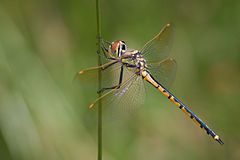Odonata
| Odonata Temporal range: Early Permian–Recent |
|
|---|---|
 |
|
| Tau emerald (Hemicordulia tau) dragonfly | |
| Scientific classification | |
| Kingdom: | Animalia |
| Phylum: | Arthropoda |
| Class: | Insecta |
| Subclass: | Pterygota |
| Infraclass: | Palaeoptera (disputed) |
| Superorder: | Odonatoptera |
| Order: |
Odonata Fabricius, 1793 |
| Suborders | |
Epiprocta (dragonflies)
Zygoptera (damselflies)
and see text
Odonata is an order of carnivorous insects, encompassing the dragonflies (Anisoptera) and the damselflies (Zygoptera). The Odonata form a clade, which has existed since the Triassic.
Dragonflies are generally larger, and perch with their wings held out to the sides; damselflies have slender bodies, and hold their wings over the body at rest.
Fabricius coined the term Odonata from the Greek οδόντoς (οδούς), odontos (tooth) apparently because they have teeth on their mandibles, even though most insects also have toothed mandibles.
The word dragonfly is also sometimes used to refer to all Odonata, but odonate is a more correct English name for the group as a whole. Odonata enthusiasts avoid ambiguity by using the term true dragonfly, or simply Anisopteran, when referring to just the Anisoptera. The term Warriorfly has also been proposed. Some 5,900 species have been described in this order.
This order has traditionally been grouped together with the mayflies and several extinct orders in a group called the "Paleoptera", but this grouping might be paraphyletic. What they do share with mayflies is the nature of how the wings are articulated and held in rest (see insect flight for a detailed discussion).
In some treatments, the Odonata are understood in an expanded sense, essentially synonymous with the superorder Odonatoptera but not including the prehistoric Protodonata. In this approach, instead of Odonatoptera, the term Odonatoidea is used. The systematics of the "Palaeoptera" are by no means resolved; what can be said however is that regardless of whether they are called "Odonatoidea" or "Odonatoptera", the Odonata and their extinct relatives do form a clade.
...
Wikipedia
